SBM3305 - Woolworths Case Study: Organizational Development Analysis
VerifiedAdded on 2023/06/12
|14
|3475
|449
Case Study
AI Summary
This case study examines the organizational development and change initiatives within Woolworths, a major retail chain. It explores the principles and theories of organizational development applicable to Woolworths' contemporary business setting, focusing on planned changes to enhance organizational performance. The analysis considers internal factors like workforce dynamics, technology, and financial performance, as well as external factors such as competition, legal changes, and economic conditions. The study highlights Woolworths' strategies for adapting to evolving consumer demands, including investments in digital marketing and mobile technology. The case study uses Lewin’s change model to explain how change is implemented within the workforce to improve performance. This document is available on Desklib, a platform offering study tools and resources for students.
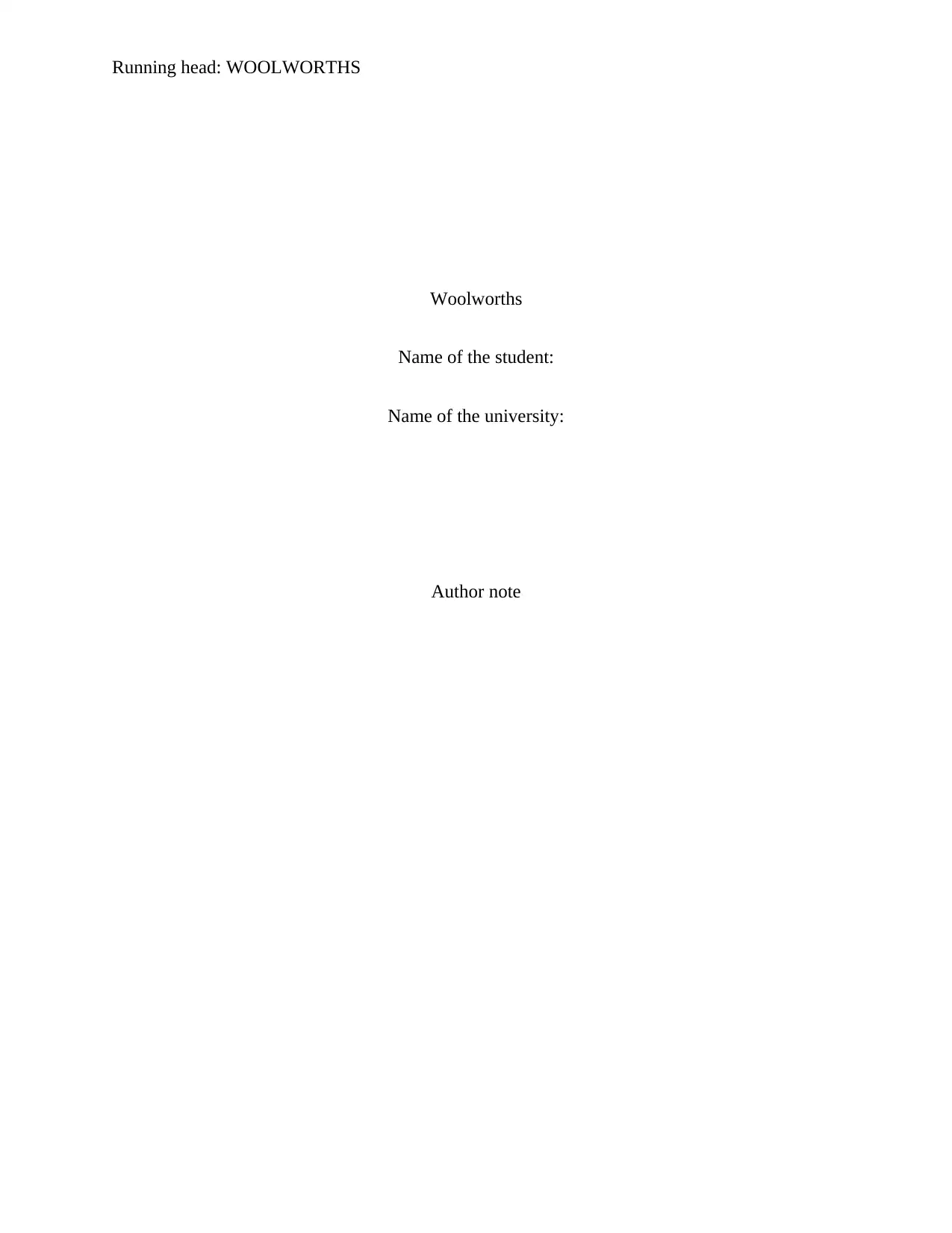
Running head: WOOLWORTHS
Woolworths
Name of the student:
Name of the university:
Author note
Woolworths
Name of the student:
Name of the university:
Author note
Paraphrase This Document
Need a fresh take? Get an instant paraphrase of this document with our AI Paraphraser
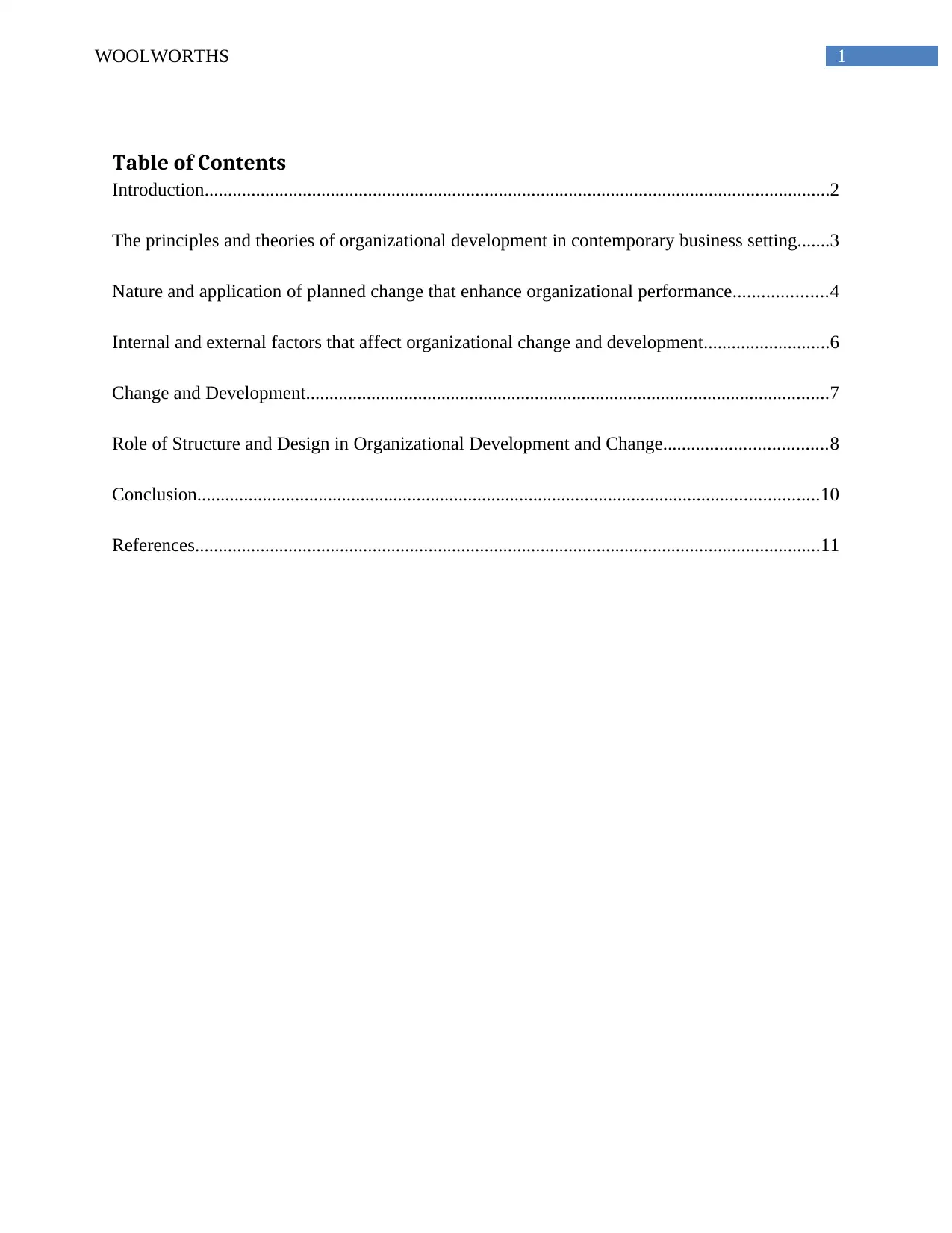
1WOOLWORTHS
Table of Contents
Introduction......................................................................................................................................2
The principles and theories of organizational development in contemporary business setting.......3
Nature and application of planned change that enhance organizational performance....................4
Internal and external factors that affect organizational change and development...........................6
Change and Development................................................................................................................7
Role of Structure and Design in Organizational Development and Change...................................8
Conclusion.....................................................................................................................................10
References......................................................................................................................................11
Table of Contents
Introduction......................................................................................................................................2
The principles and theories of organizational development in contemporary business setting.......3
Nature and application of planned change that enhance organizational performance....................4
Internal and external factors that affect organizational change and development...........................6
Change and Development................................................................................................................7
Role of Structure and Design in Organizational Development and Change...................................8
Conclusion.....................................................................................................................................10
References......................................................................................................................................11
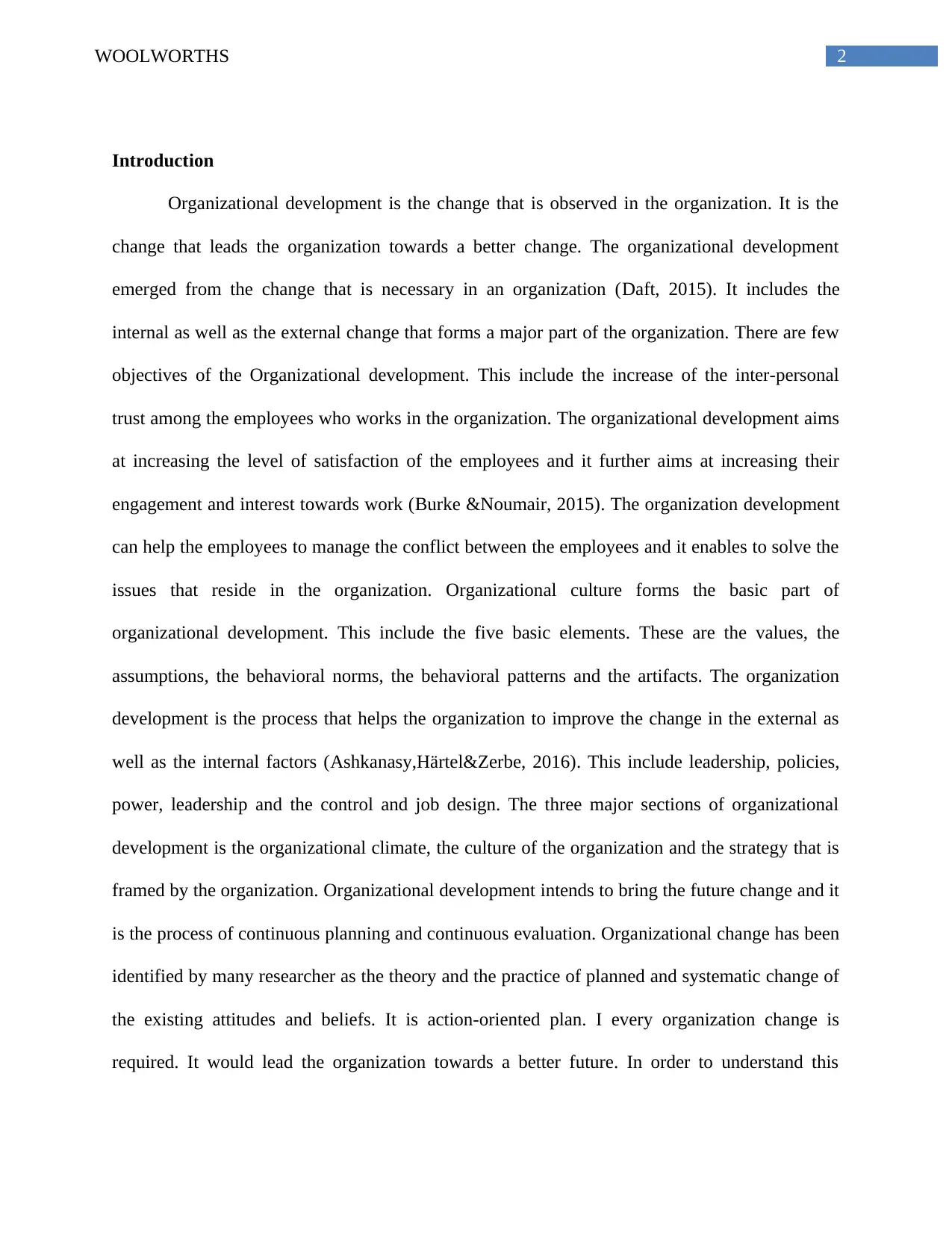
2WOOLWORTHS
Introduction
Organizational development is the change that is observed in the organization. It is the
change that leads the organization towards a better change. The organizational development
emerged from the change that is necessary in an organization (Daft, 2015). It includes the
internal as well as the external change that forms a major part of the organization. There are few
objectives of the Organizational development. This include the increase of the inter-personal
trust among the employees who works in the organization. The organizational development aims
at increasing the level of satisfaction of the employees and it further aims at increasing their
engagement and interest towards work (Burke &Noumair, 2015). The organization development
can help the employees to manage the conflict between the employees and it enables to solve the
issues that reside in the organization. Organizational culture forms the basic part of
organizational development. This include the five basic elements. These are the values, the
assumptions, the behavioral norms, the behavioral patterns and the artifacts. The organization
development is the process that helps the organization to improve the change in the external as
well as the internal factors (Ashkanasy,Härtel&Zerbe, 2016). This include leadership, policies,
power, leadership and the control and job design. The three major sections of organizational
development is the organizational climate, the culture of the organization and the strategy that is
framed by the organization. Organizational development intends to bring the future change and it
is the process of continuous planning and continuous evaluation. Organizational change has been
identified by many researcher as the theory and the practice of planned and systematic change of
the existing attitudes and beliefs. It is action-oriented plan. I every organization change is
required. It would lead the organization towards a better future. In order to understand this
Introduction
Organizational development is the change that is observed in the organization. It is the
change that leads the organization towards a better change. The organizational development
emerged from the change that is necessary in an organization (Daft, 2015). It includes the
internal as well as the external change that forms a major part of the organization. There are few
objectives of the Organizational development. This include the increase of the inter-personal
trust among the employees who works in the organization. The organizational development aims
at increasing the level of satisfaction of the employees and it further aims at increasing their
engagement and interest towards work (Burke &Noumair, 2015). The organization development
can help the employees to manage the conflict between the employees and it enables to solve the
issues that reside in the organization. Organizational culture forms the basic part of
organizational development. This include the five basic elements. These are the values, the
assumptions, the behavioral norms, the behavioral patterns and the artifacts. The organization
development is the process that helps the organization to improve the change in the external as
well as the internal factors (Ashkanasy,Härtel&Zerbe, 2016). This include leadership, policies,
power, leadership and the control and job design. The three major sections of organizational
development is the organizational climate, the culture of the organization and the strategy that is
framed by the organization. Organizational development intends to bring the future change and it
is the process of continuous planning and continuous evaluation. Organizational change has been
identified by many researcher as the theory and the practice of planned and systematic change of
the existing attitudes and beliefs. It is action-oriented plan. I every organization change is
required. It would lead the organization towards a better future. In order to understand this
⊘ This is a preview!⊘
Do you want full access?
Subscribe today to unlock all pages.

Trusted by 1+ million students worldwide
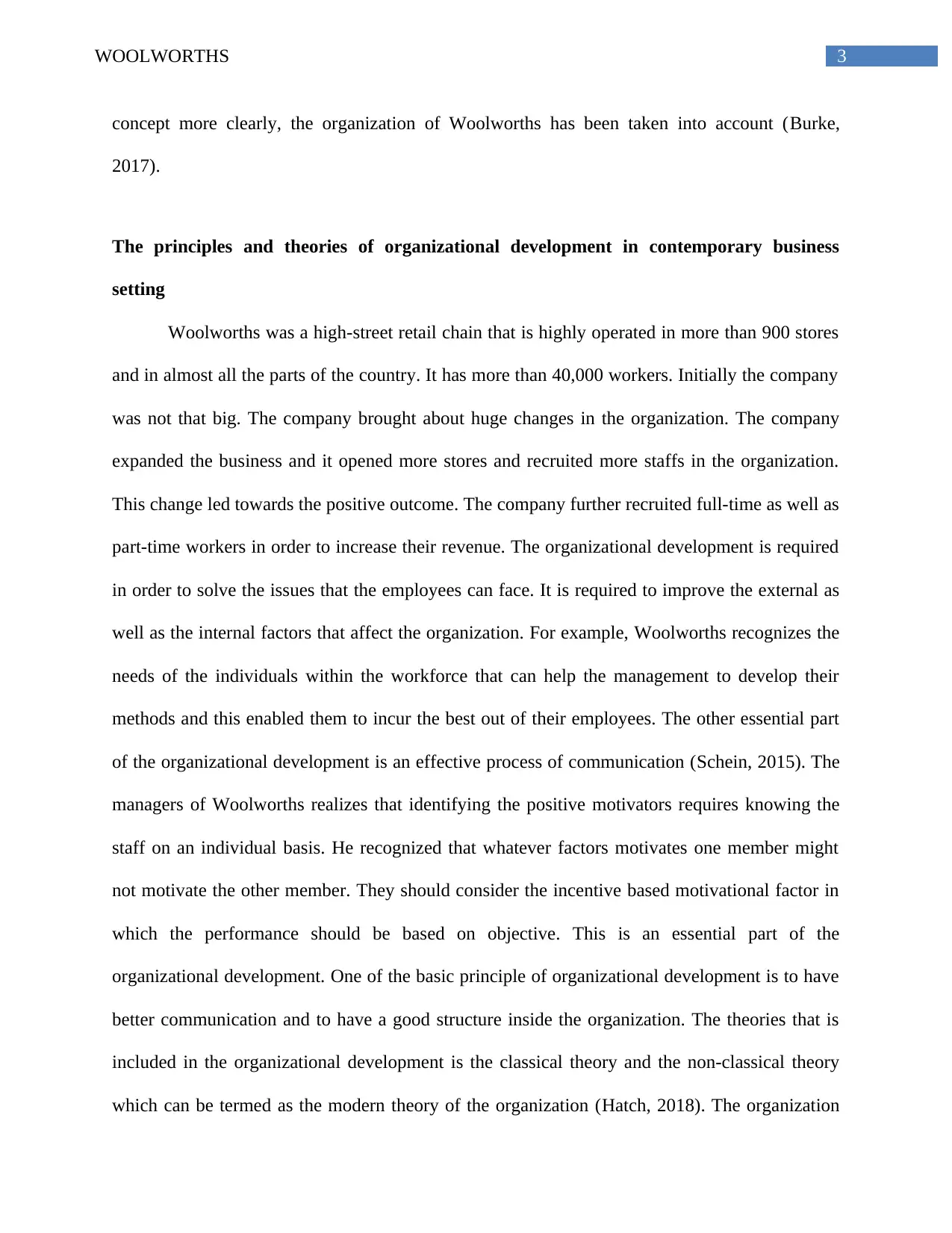
3WOOLWORTHS
concept more clearly, the organization of Woolworths has been taken into account (Burke,
2017).
The principles and theories of organizational development in contemporary business
setting
Woolworths was a high-street retail chain that is highly operated in more than 900 stores
and in almost all the parts of the country. It has more than 40,000 workers. Initially the company
was not that big. The company brought about huge changes in the organization. The company
expanded the business and it opened more stores and recruited more staffs in the organization.
This change led towards the positive outcome. The company further recruited full-time as well as
part-time workers in order to increase their revenue. The organizational development is required
in order to solve the issues that the employees can face. It is required to improve the external as
well as the internal factors that affect the organization. For example, Woolworths recognizes the
needs of the individuals within the workforce that can help the management to develop their
methods and this enabled them to incur the best out of their employees. The other essential part
of the organizational development is an effective process of communication (Schein, 2015). The
managers of Woolworths realizes that identifying the positive motivators requires knowing the
staff on an individual basis. He recognized that whatever factors motivates one member might
not motivate the other member. They should consider the incentive based motivational factor in
which the performance should be based on objective. This is an essential part of the
organizational development. One of the basic principle of organizational development is to have
better communication and to have a good structure inside the organization. The theories that is
included in the organizational development is the classical theory and the non-classical theory
which can be termed as the modern theory of the organization (Hatch, 2018). The organization
concept more clearly, the organization of Woolworths has been taken into account (Burke,
2017).
The principles and theories of organizational development in contemporary business
setting
Woolworths was a high-street retail chain that is highly operated in more than 900 stores
and in almost all the parts of the country. It has more than 40,000 workers. Initially the company
was not that big. The company brought about huge changes in the organization. The company
expanded the business and it opened more stores and recruited more staffs in the organization.
This change led towards the positive outcome. The company further recruited full-time as well as
part-time workers in order to increase their revenue. The organizational development is required
in order to solve the issues that the employees can face. It is required to improve the external as
well as the internal factors that affect the organization. For example, Woolworths recognizes the
needs of the individuals within the workforce that can help the management to develop their
methods and this enabled them to incur the best out of their employees. The other essential part
of the organizational development is an effective process of communication (Schein, 2015). The
managers of Woolworths realizes that identifying the positive motivators requires knowing the
staff on an individual basis. He recognized that whatever factors motivates one member might
not motivate the other member. They should consider the incentive based motivational factor in
which the performance should be based on objective. This is an essential part of the
organizational development. One of the basic principle of organizational development is to have
better communication and to have a good structure inside the organization. The theories that is
included in the organizational development is the classical theory and the non-classical theory
which can be termed as the modern theory of the organization (Hatch, 2018). The organization
Paraphrase This Document
Need a fresh take? Get an instant paraphrase of this document with our AI Paraphraser
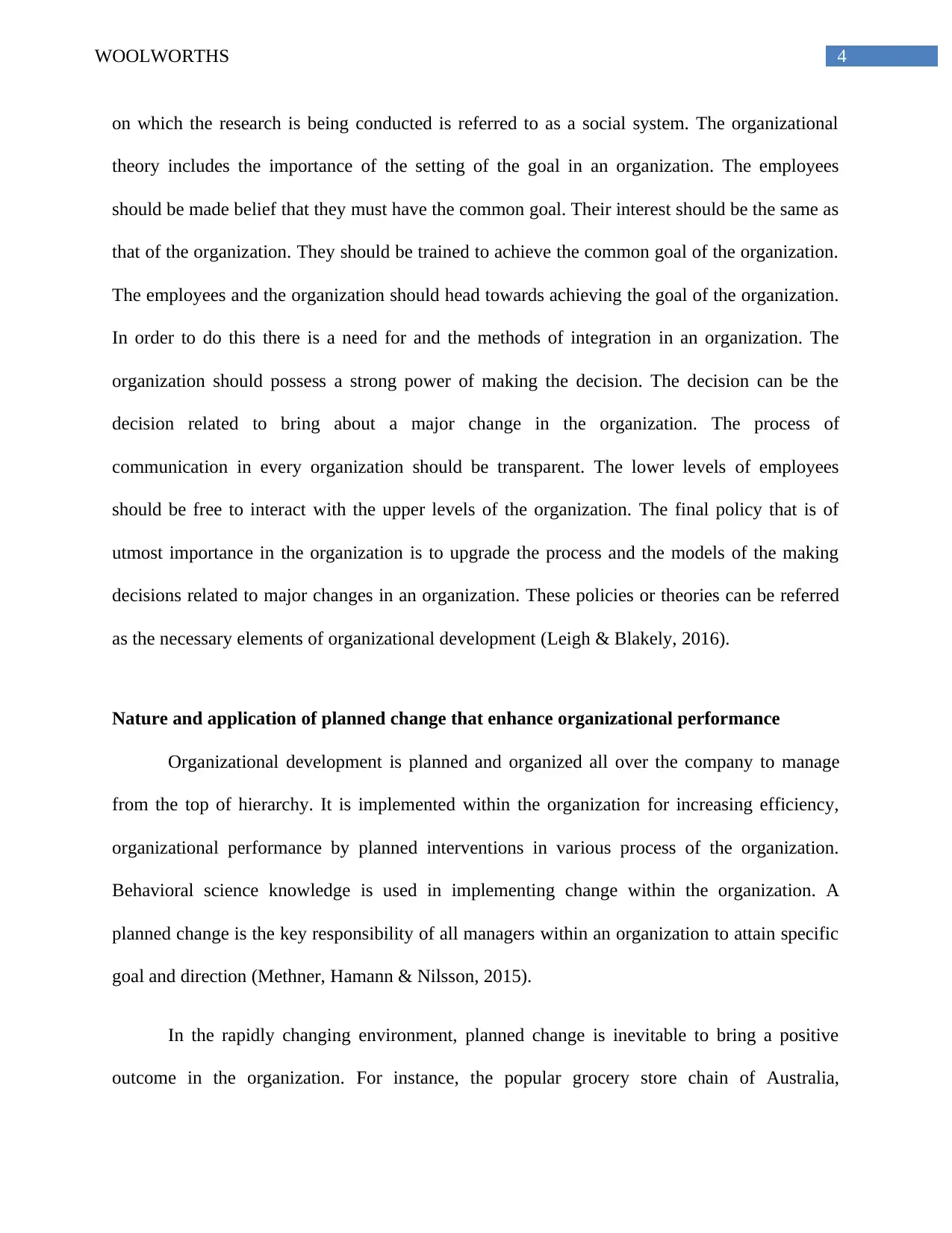
4WOOLWORTHS
on which the research is being conducted is referred to as a social system. The organizational
theory includes the importance of the setting of the goal in an organization. The employees
should be made belief that they must have the common goal. Their interest should be the same as
that of the organization. They should be trained to achieve the common goal of the organization.
The employees and the organization should head towards achieving the goal of the organization.
In order to do this there is a need for and the methods of integration in an organization. The
organization should possess a strong power of making the decision. The decision can be the
decision related to bring about a major change in the organization. The process of
communication in every organization should be transparent. The lower levels of employees
should be free to interact with the upper levels of the organization. The final policy that is of
utmost importance in the organization is to upgrade the process and the models of the making
decisions related to major changes in an organization. These policies or theories can be referred
as the necessary elements of organizational development (Leigh & Blakely, 2016).
Nature and application of planned change that enhance organizational performance
Organizational development is planned and organized all over the company to manage
from the top of hierarchy. It is implemented within the organization for increasing efficiency,
organizational performance by planned interventions in various process of the organization.
Behavioral science knowledge is used in implementing change within the organization. A
planned change is the key responsibility of all managers within an organization to attain specific
goal and direction (Methner, Hamann & Nilsson, 2015).
In the rapidly changing environment, planned change is inevitable to bring a positive
outcome in the organization. For instance, the popular grocery store chain of Australia,
on which the research is being conducted is referred to as a social system. The organizational
theory includes the importance of the setting of the goal in an organization. The employees
should be made belief that they must have the common goal. Their interest should be the same as
that of the organization. They should be trained to achieve the common goal of the organization.
The employees and the organization should head towards achieving the goal of the organization.
In order to do this there is a need for and the methods of integration in an organization. The
organization should possess a strong power of making the decision. The decision can be the
decision related to bring about a major change in the organization. The process of
communication in every organization should be transparent. The lower levels of employees
should be free to interact with the upper levels of the organization. The final policy that is of
utmost importance in the organization is to upgrade the process and the models of the making
decisions related to major changes in an organization. These policies or theories can be referred
as the necessary elements of organizational development (Leigh & Blakely, 2016).
Nature and application of planned change that enhance organizational performance
Organizational development is planned and organized all over the company to manage
from the top of hierarchy. It is implemented within the organization for increasing efficiency,
organizational performance by planned interventions in various process of the organization.
Behavioral science knowledge is used in implementing change within the organization. A
planned change is the key responsibility of all managers within an organization to attain specific
goal and direction (Methner, Hamann & Nilsson, 2015).
In the rapidly changing environment, planned change is inevitable to bring a positive
outcome in the organization. For instance, the popular grocery store chain of Australia,
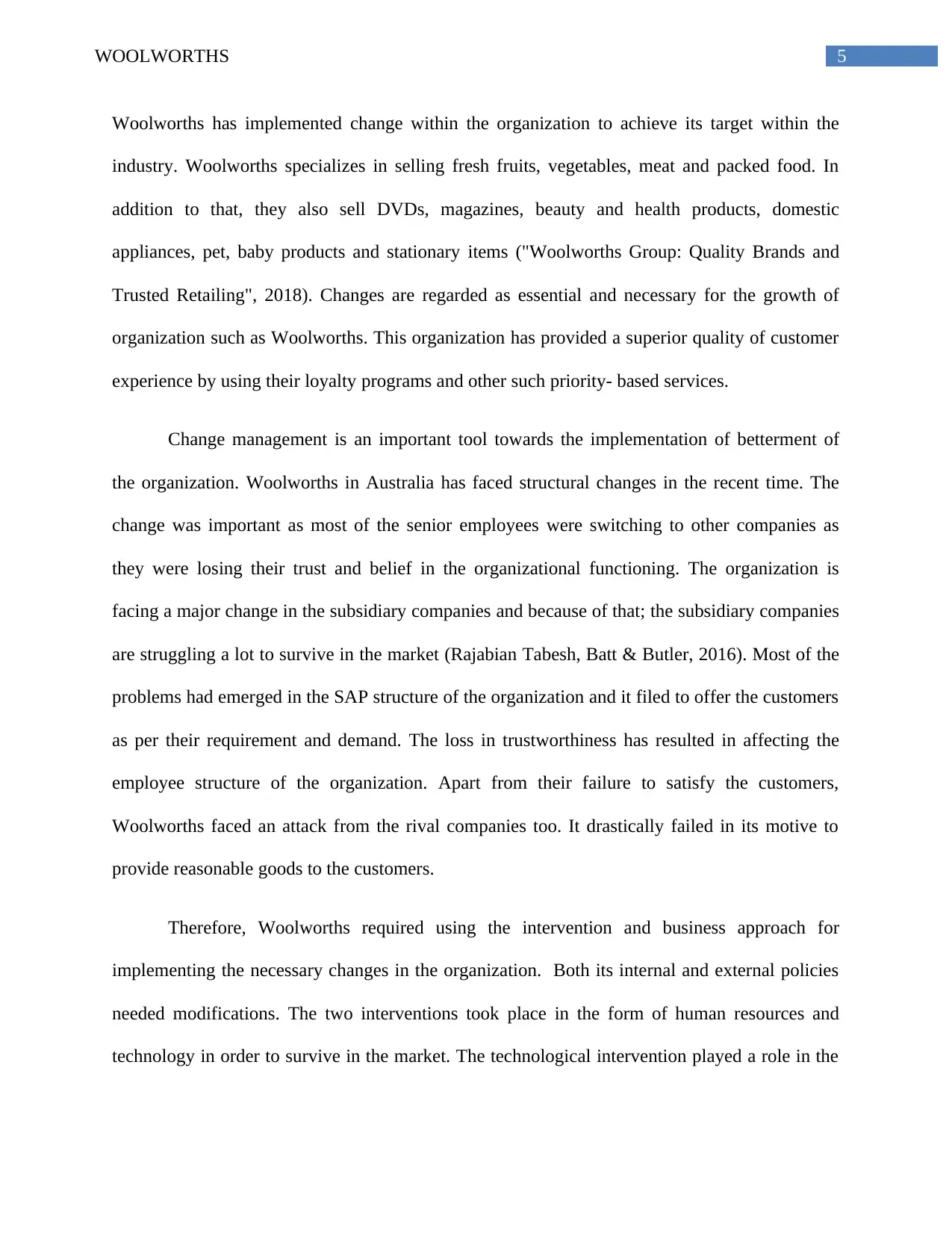
5WOOLWORTHS
Woolworths has implemented change within the organization to achieve its target within the
industry. Woolworths specializes in selling fresh fruits, vegetables, meat and packed food. In
addition to that, they also sell DVDs, magazines, beauty and health products, domestic
appliances, pet, baby products and stationary items ("Woolworths Group: Quality Brands and
Trusted Retailing", 2018). Changes are regarded as essential and necessary for the growth of
organization such as Woolworths. This organization has provided a superior quality of customer
experience by using their loyalty programs and other such priority- based services.
Change management is an important tool towards the implementation of betterment of
the organization. Woolworths in Australia has faced structural changes in the recent time. The
change was important as most of the senior employees were switching to other companies as
they were losing their trust and belief in the organizational functioning. The organization is
facing a major change in the subsidiary companies and because of that; the subsidiary companies
are struggling a lot to survive in the market (Rajabian Tabesh, Batt & Butler, 2016). Most of the
problems had emerged in the SAP structure of the organization and it filed to offer the customers
as per their requirement and demand. The loss in trustworthiness has resulted in affecting the
employee structure of the organization. Apart from their failure to satisfy the customers,
Woolworths faced an attack from the rival companies too. It drastically failed in its motive to
provide reasonable goods to the customers.
Therefore, Woolworths required using the intervention and business approach for
implementing the necessary changes in the organization. Both its internal and external policies
needed modifications. The two interventions took place in the form of human resources and
technology in order to survive in the market. The technological intervention played a role in the
Woolworths has implemented change within the organization to achieve its target within the
industry. Woolworths specializes in selling fresh fruits, vegetables, meat and packed food. In
addition to that, they also sell DVDs, magazines, beauty and health products, domestic
appliances, pet, baby products and stationary items ("Woolworths Group: Quality Brands and
Trusted Retailing", 2018). Changes are regarded as essential and necessary for the growth of
organization such as Woolworths. This organization has provided a superior quality of customer
experience by using their loyalty programs and other such priority- based services.
Change management is an important tool towards the implementation of betterment of
the organization. Woolworths in Australia has faced structural changes in the recent time. The
change was important as most of the senior employees were switching to other companies as
they were losing their trust and belief in the organizational functioning. The organization is
facing a major change in the subsidiary companies and because of that; the subsidiary companies
are struggling a lot to survive in the market (Rajabian Tabesh, Batt & Butler, 2016). Most of the
problems had emerged in the SAP structure of the organization and it filed to offer the customers
as per their requirement and demand. The loss in trustworthiness has resulted in affecting the
employee structure of the organization. Apart from their failure to satisfy the customers,
Woolworths faced an attack from the rival companies too. It drastically failed in its motive to
provide reasonable goods to the customers.
Therefore, Woolworths required using the intervention and business approach for
implementing the necessary changes in the organization. Both its internal and external policies
needed modifications. The two interventions took place in the form of human resources and
technology in order to survive in the market. The technological intervention played a role in the
⊘ This is a preview!⊘
Do you want full access?
Subscribe today to unlock all pages.

Trusted by 1+ million students worldwide
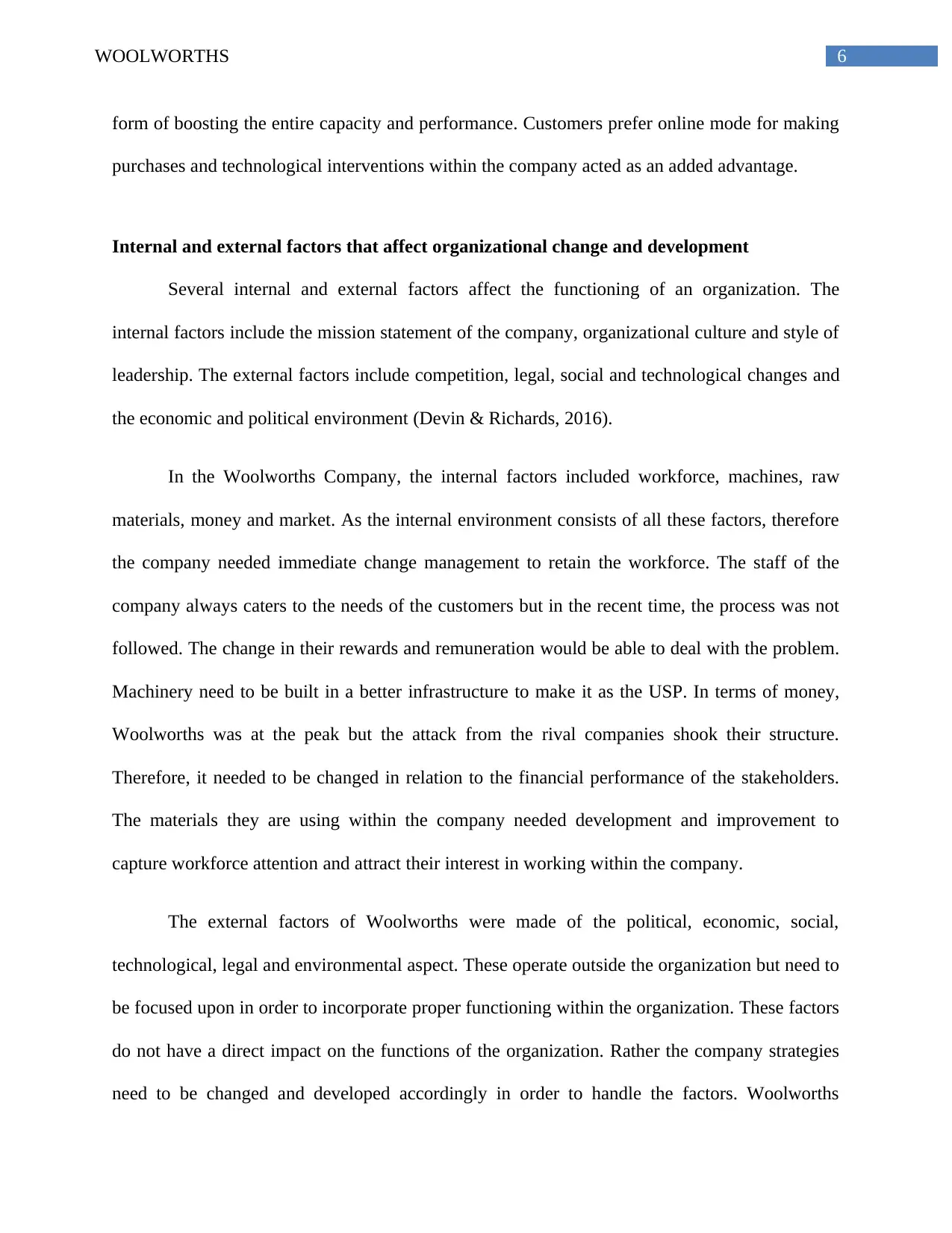
6WOOLWORTHS
form of boosting the entire capacity and performance. Customers prefer online mode for making
purchases and technological interventions within the company acted as an added advantage.
Internal and external factors that affect organizational change and development
Several internal and external factors affect the functioning of an organization. The
internal factors include the mission statement of the company, organizational culture and style of
leadership. The external factors include competition, legal, social and technological changes and
the economic and political environment (Devin & Richards, 2016).
In the Woolworths Company, the internal factors included workforce, machines, raw
materials, money and market. As the internal environment consists of all these factors, therefore
the company needed immediate change management to retain the workforce. The staff of the
company always caters to the needs of the customers but in the recent time, the process was not
followed. The change in their rewards and remuneration would be able to deal with the problem.
Machinery need to be built in a better infrastructure to make it as the USP. In terms of money,
Woolworths was at the peak but the attack from the rival companies shook their structure.
Therefore, it needed to be changed in relation to the financial performance of the stakeholders.
The materials they are using within the company needed development and improvement to
capture workforce attention and attract their interest in working within the company.
The external factors of Woolworths were made of the political, economic, social,
technological, legal and environmental aspect. These operate outside the organization but need to
be focused upon in order to incorporate proper functioning within the organization. These factors
do not have a direct impact on the functions of the organization. Rather the company strategies
need to be changed and developed accordingly in order to handle the factors. Woolworths
form of boosting the entire capacity and performance. Customers prefer online mode for making
purchases and technological interventions within the company acted as an added advantage.
Internal and external factors that affect organizational change and development
Several internal and external factors affect the functioning of an organization. The
internal factors include the mission statement of the company, organizational culture and style of
leadership. The external factors include competition, legal, social and technological changes and
the economic and political environment (Devin & Richards, 2016).
In the Woolworths Company, the internal factors included workforce, machines, raw
materials, money and market. As the internal environment consists of all these factors, therefore
the company needed immediate change management to retain the workforce. The staff of the
company always caters to the needs of the customers but in the recent time, the process was not
followed. The change in their rewards and remuneration would be able to deal with the problem.
Machinery need to be built in a better infrastructure to make it as the USP. In terms of money,
Woolworths was at the peak but the attack from the rival companies shook their structure.
Therefore, it needed to be changed in relation to the financial performance of the stakeholders.
The materials they are using within the company needed development and improvement to
capture workforce attention and attract their interest in working within the company.
The external factors of Woolworths were made of the political, economic, social,
technological, legal and environmental aspect. These operate outside the organization but need to
be focused upon in order to incorporate proper functioning within the organization. These factors
do not have a direct impact on the functions of the organization. Rather the company strategies
need to be changed and developed accordingly in order to handle the factors. Woolworths
Paraphrase This Document
Need a fresh take? Get an instant paraphrase of this document with our AI Paraphraser
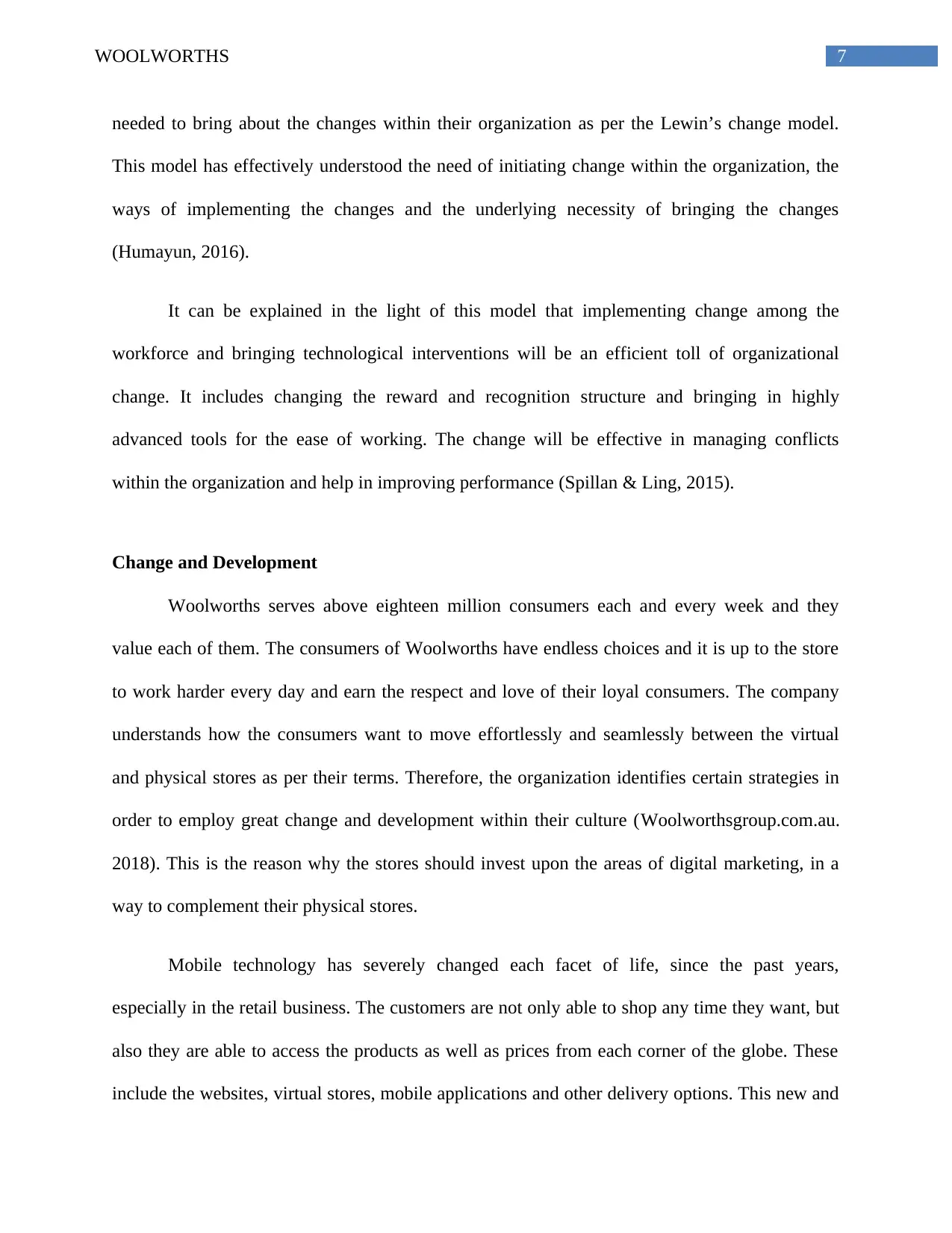
7WOOLWORTHS
needed to bring about the changes within their organization as per the Lewin’s change model.
This model has effectively understood the need of initiating change within the organization, the
ways of implementing the changes and the underlying necessity of bringing the changes
(Humayun, 2016).
It can be explained in the light of this model that implementing change among the
workforce and bringing technological interventions will be an efficient toll of organizational
change. It includes changing the reward and recognition structure and bringing in highly
advanced tools for the ease of working. The change will be effective in managing conflicts
within the organization and help in improving performance (Spillan & Ling, 2015).
Change and Development
Woolworths serves above eighteen million consumers each and every week and they
value each of them. The consumers of Woolworths have endless choices and it is up to the store
to work harder every day and earn the respect and love of their loyal consumers. The company
understands how the consumers want to move effortlessly and seamlessly between the virtual
and physical stores as per their terms. Therefore, the organization identifies certain strategies in
order to employ great change and development within their culture (Woolworthsgroup.com.au.
2018). This is the reason why the stores should invest upon the areas of digital marketing, in a
way to complement their physical stores.
Mobile technology has severely changed each facet of life, since the past years,
especially in the retail business. The customers are not only able to shop any time they want, but
also they are able to access the products as well as prices from each corner of the globe. These
include the websites, virtual stores, mobile applications and other delivery options. This new and
needed to bring about the changes within their organization as per the Lewin’s change model.
This model has effectively understood the need of initiating change within the organization, the
ways of implementing the changes and the underlying necessity of bringing the changes
(Humayun, 2016).
It can be explained in the light of this model that implementing change among the
workforce and bringing technological interventions will be an efficient toll of organizational
change. It includes changing the reward and recognition structure and bringing in highly
advanced tools for the ease of working. The change will be effective in managing conflicts
within the organization and help in improving performance (Spillan & Ling, 2015).
Change and Development
Woolworths serves above eighteen million consumers each and every week and they
value each of them. The consumers of Woolworths have endless choices and it is up to the store
to work harder every day and earn the respect and love of their loyal consumers. The company
understands how the consumers want to move effortlessly and seamlessly between the virtual
and physical stores as per their terms. Therefore, the organization identifies certain strategies in
order to employ great change and development within their culture (Woolworthsgroup.com.au.
2018). This is the reason why the stores should invest upon the areas of digital marketing, in a
way to complement their physical stores.
Mobile technology has severely changed each facet of life, since the past years,
especially in the retail business. The customers are not only able to shop any time they want, but
also they are able to access the products as well as prices from each corner of the globe. These
include the websites, virtual stores, mobile applications and other delivery options. This new and
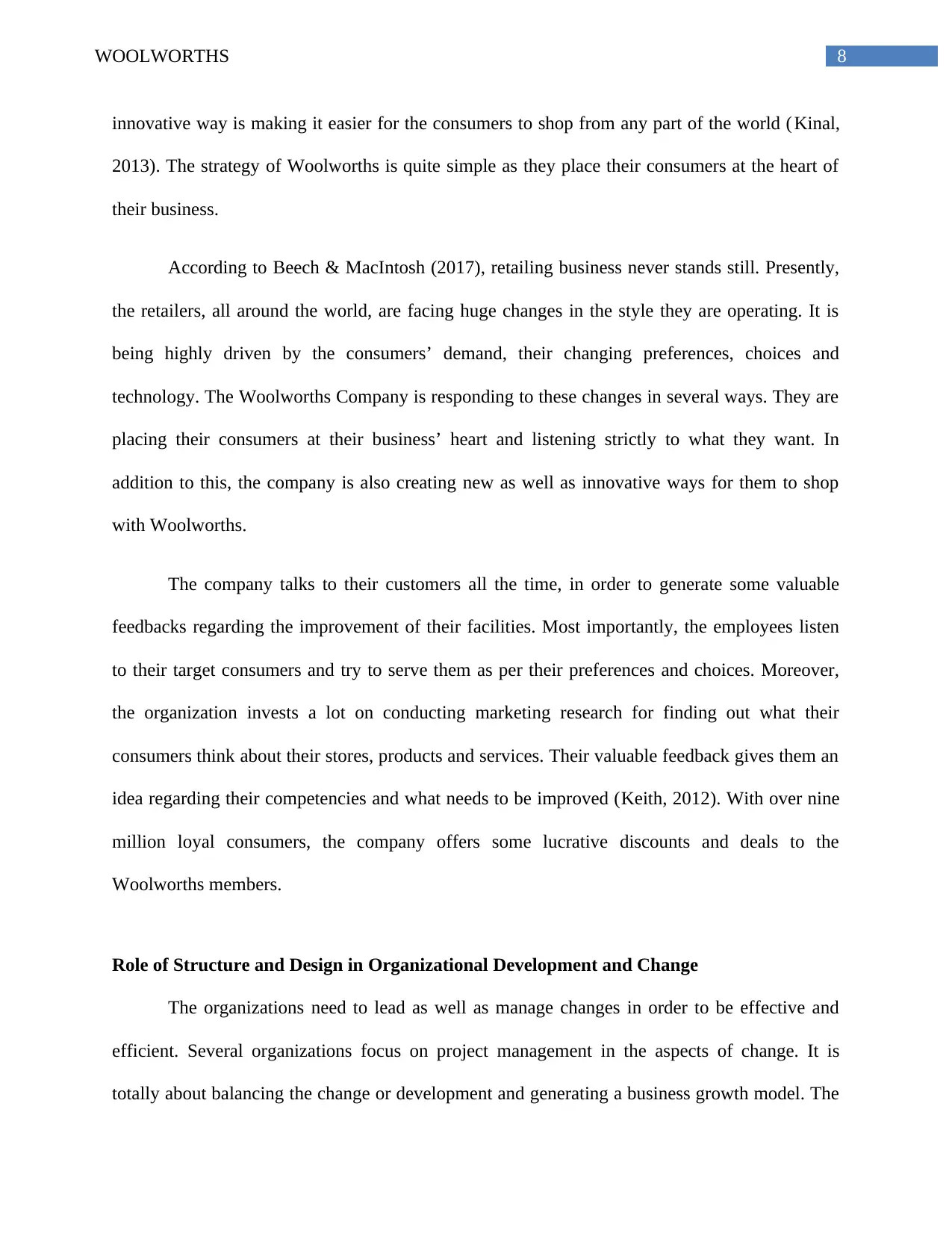
8WOOLWORTHS
innovative way is making it easier for the consumers to shop from any part of the world (Kinal,
2013). The strategy of Woolworths is quite simple as they place their consumers at the heart of
their business.
According to Beech & MacIntosh (2017), retailing business never stands still. Presently,
the retailers, all around the world, are facing huge changes in the style they are operating. It is
being highly driven by the consumers’ demand, their changing preferences, choices and
technology. The Woolworths Company is responding to these changes in several ways. They are
placing their consumers at their business’ heart and listening strictly to what they want. In
addition to this, the company is also creating new as well as innovative ways for them to shop
with Woolworths.
The company talks to their customers all the time, in order to generate some valuable
feedbacks regarding the improvement of their facilities. Most importantly, the employees listen
to their target consumers and try to serve them as per their preferences and choices. Moreover,
the organization invests a lot on conducting marketing research for finding out what their
consumers think about their stores, products and services. Their valuable feedback gives them an
idea regarding their competencies and what needs to be improved (Keith, 2012). With over nine
million loyal consumers, the company offers some lucrative discounts and deals to the
Woolworths members.
Role of Structure and Design in Organizational Development and Change
The organizations need to lead as well as manage changes in order to be effective and
efficient. Several organizations focus on project management in the aspects of change. It is
totally about balancing the change or development and generating a business growth model. The
innovative way is making it easier for the consumers to shop from any part of the world (Kinal,
2013). The strategy of Woolworths is quite simple as they place their consumers at the heart of
their business.
According to Beech & MacIntosh (2017), retailing business never stands still. Presently,
the retailers, all around the world, are facing huge changes in the style they are operating. It is
being highly driven by the consumers’ demand, their changing preferences, choices and
technology. The Woolworths Company is responding to these changes in several ways. They are
placing their consumers at their business’ heart and listening strictly to what they want. In
addition to this, the company is also creating new as well as innovative ways for them to shop
with Woolworths.
The company talks to their customers all the time, in order to generate some valuable
feedbacks regarding the improvement of their facilities. Most importantly, the employees listen
to their target consumers and try to serve them as per their preferences and choices. Moreover,
the organization invests a lot on conducting marketing research for finding out what their
consumers think about their stores, products and services. Their valuable feedback gives them an
idea regarding their competencies and what needs to be improved (Keith, 2012). With over nine
million loyal consumers, the company offers some lucrative discounts and deals to the
Woolworths members.
Role of Structure and Design in Organizational Development and Change
The organizations need to lead as well as manage changes in order to be effective and
efficient. Several organizations focus on project management in the aspects of change. It is
totally about balancing the change or development and generating a business growth model. The
⊘ This is a preview!⊘
Do you want full access?
Subscribe today to unlock all pages.

Trusted by 1+ million students worldwide
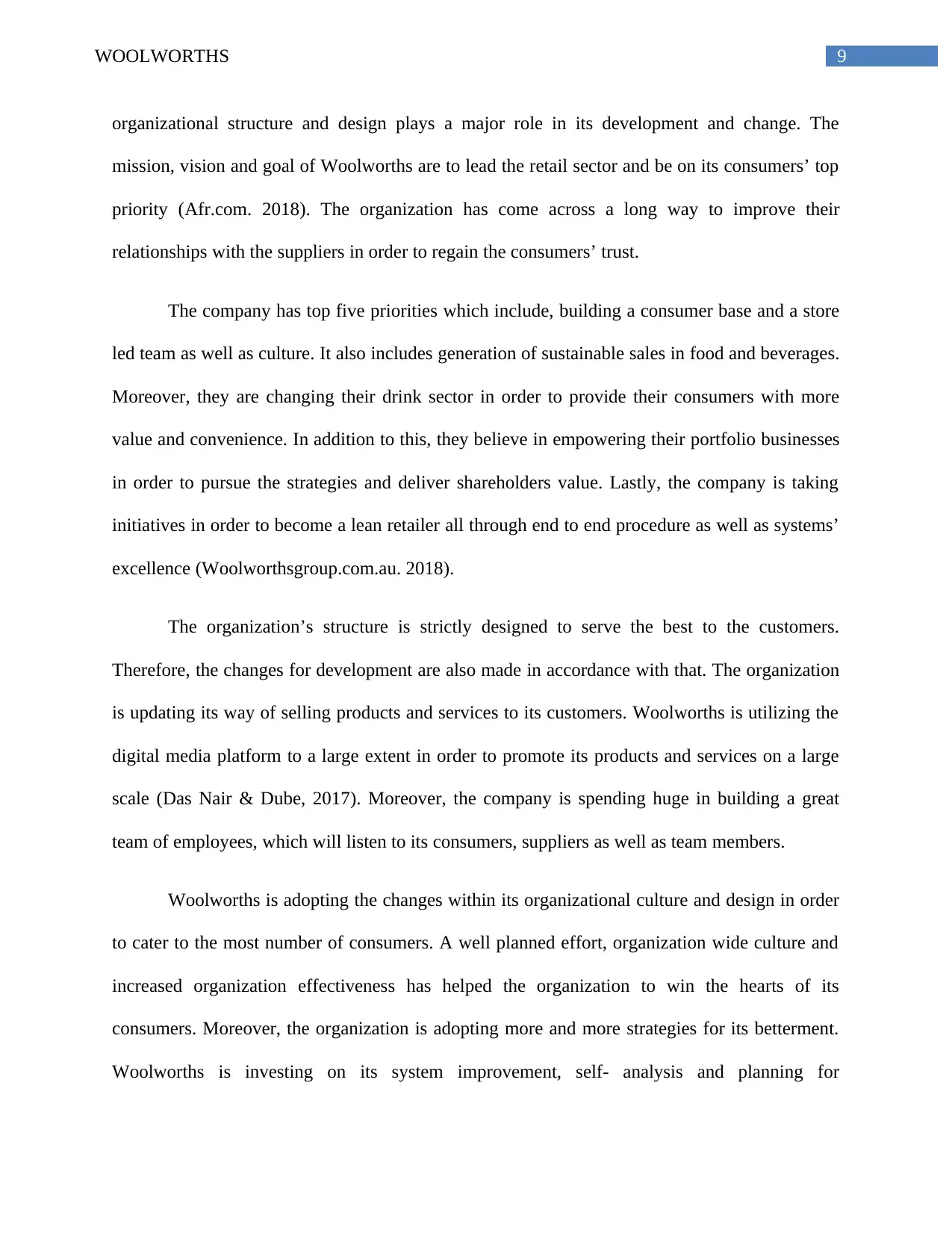
9WOOLWORTHS
organizational structure and design plays a major role in its development and change. The
mission, vision and goal of Woolworths are to lead the retail sector and be on its consumers’ top
priority (Afr.com. 2018). The organization has come across a long way to improve their
relationships with the suppliers in order to regain the consumers’ trust.
The company has top five priorities which include, building a consumer base and a store
led team as well as culture. It also includes generation of sustainable sales in food and beverages.
Moreover, they are changing their drink sector in order to provide their consumers with more
value and convenience. In addition to this, they believe in empowering their portfolio businesses
in order to pursue the strategies and deliver shareholders value. Lastly, the company is taking
initiatives in order to become a lean retailer all through end to end procedure as well as systems’
excellence (Woolworthsgroup.com.au. 2018).
The organization’s structure is strictly designed to serve the best to the customers.
Therefore, the changes for development are also made in accordance with that. The organization
is updating its way of selling products and services to its customers. Woolworths is utilizing the
digital media platform to a large extent in order to promote its products and services on a large
scale (Das Nair & Dube, 2017). Moreover, the company is spending huge in building a great
team of employees, which will listen to its consumers, suppliers as well as team members.
Woolworths is adopting the changes within its organizational culture and design in order
to cater to the most number of consumers. A well planned effort, organization wide culture and
increased organization effectiveness has helped the organization to win the hearts of its
consumers. Moreover, the organization is adopting more and more strategies for its betterment.
Woolworths is investing on its system improvement, self- analysis and planning for
organizational structure and design plays a major role in its development and change. The
mission, vision and goal of Woolworths are to lead the retail sector and be on its consumers’ top
priority (Afr.com. 2018). The organization has come across a long way to improve their
relationships with the suppliers in order to regain the consumers’ trust.
The company has top five priorities which include, building a consumer base and a store
led team as well as culture. It also includes generation of sustainable sales in food and beverages.
Moreover, they are changing their drink sector in order to provide their consumers with more
value and convenience. In addition to this, they believe in empowering their portfolio businesses
in order to pursue the strategies and deliver shareholders value. Lastly, the company is taking
initiatives in order to become a lean retailer all through end to end procedure as well as systems’
excellence (Woolworthsgroup.com.au. 2018).
The organization’s structure is strictly designed to serve the best to the customers.
Therefore, the changes for development are also made in accordance with that. The organization
is updating its way of selling products and services to its customers. Woolworths is utilizing the
digital media platform to a large extent in order to promote its products and services on a large
scale (Das Nair & Dube, 2017). Moreover, the company is spending huge in building a great
team of employees, which will listen to its consumers, suppliers as well as team members.
Woolworths is adopting the changes within its organizational culture and design in order
to cater to the most number of consumers. A well planned effort, organization wide culture and
increased organization effectiveness has helped the organization to win the hearts of its
consumers. Moreover, the organization is adopting more and more strategies for its betterment.
Woolworths is investing on its system improvement, self- analysis and planning for
Paraphrase This Document
Need a fresh take? Get an instant paraphrase of this document with our AI Paraphraser
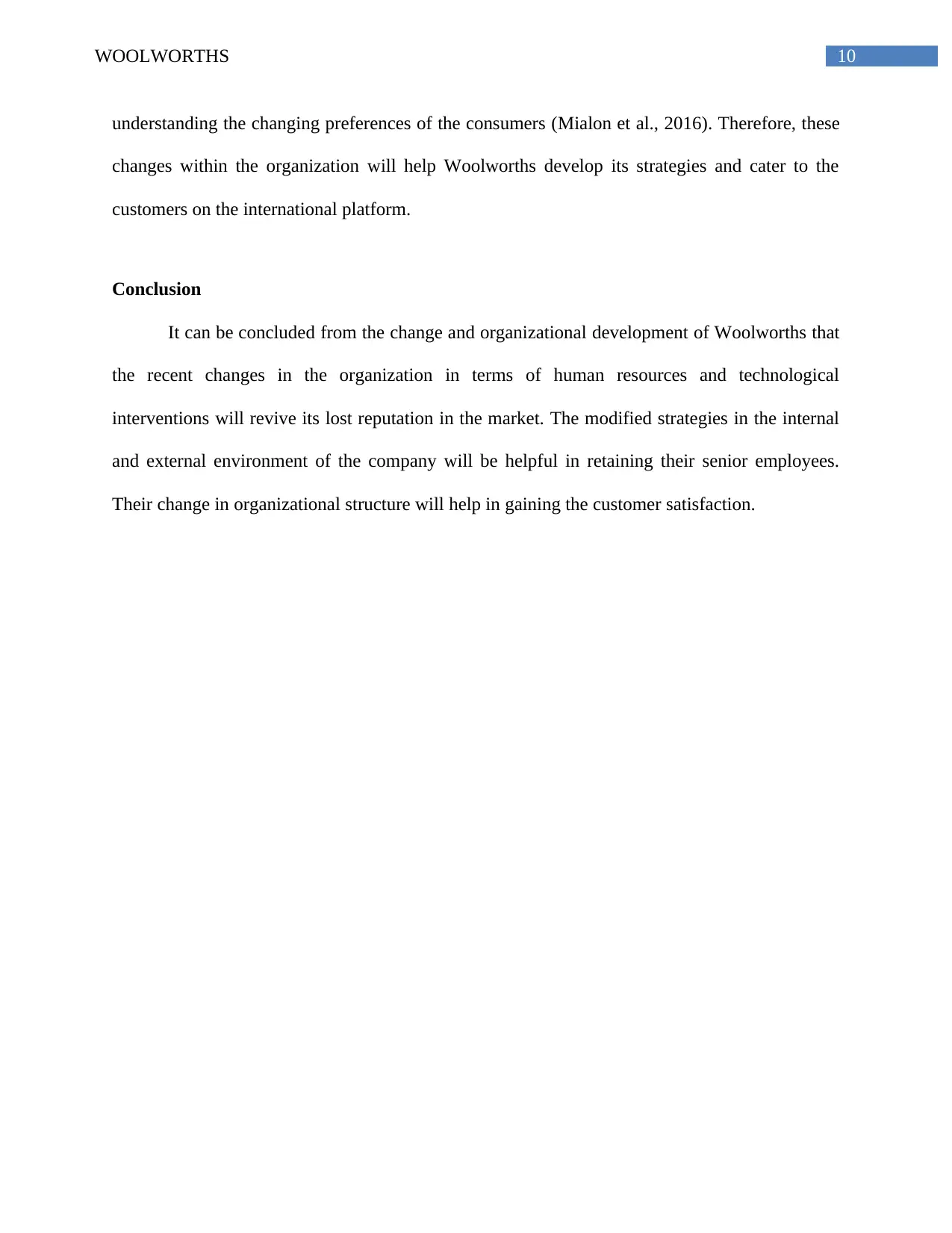
10WOOLWORTHS
understanding the changing preferences of the consumers (Mialon et al., 2016). Therefore, these
changes within the organization will help Woolworths develop its strategies and cater to the
customers on the international platform.
Conclusion
It can be concluded from the change and organizational development of Woolworths that
the recent changes in the organization in terms of human resources and technological
interventions will revive its lost reputation in the market. The modified strategies in the internal
and external environment of the company will be helpful in retaining their senior employees.
Their change in organizational structure will help in gaining the customer satisfaction.
understanding the changing preferences of the consumers (Mialon et al., 2016). Therefore, these
changes within the organization will help Woolworths develop its strategies and cater to the
customers on the international platform.
Conclusion
It can be concluded from the change and organizational development of Woolworths that
the recent changes in the organization in terms of human resources and technological
interventions will revive its lost reputation in the market. The modified strategies in the internal
and external environment of the company will be helpful in retaining their senior employees.
Their change in organizational structure will help in gaining the customer satisfaction.
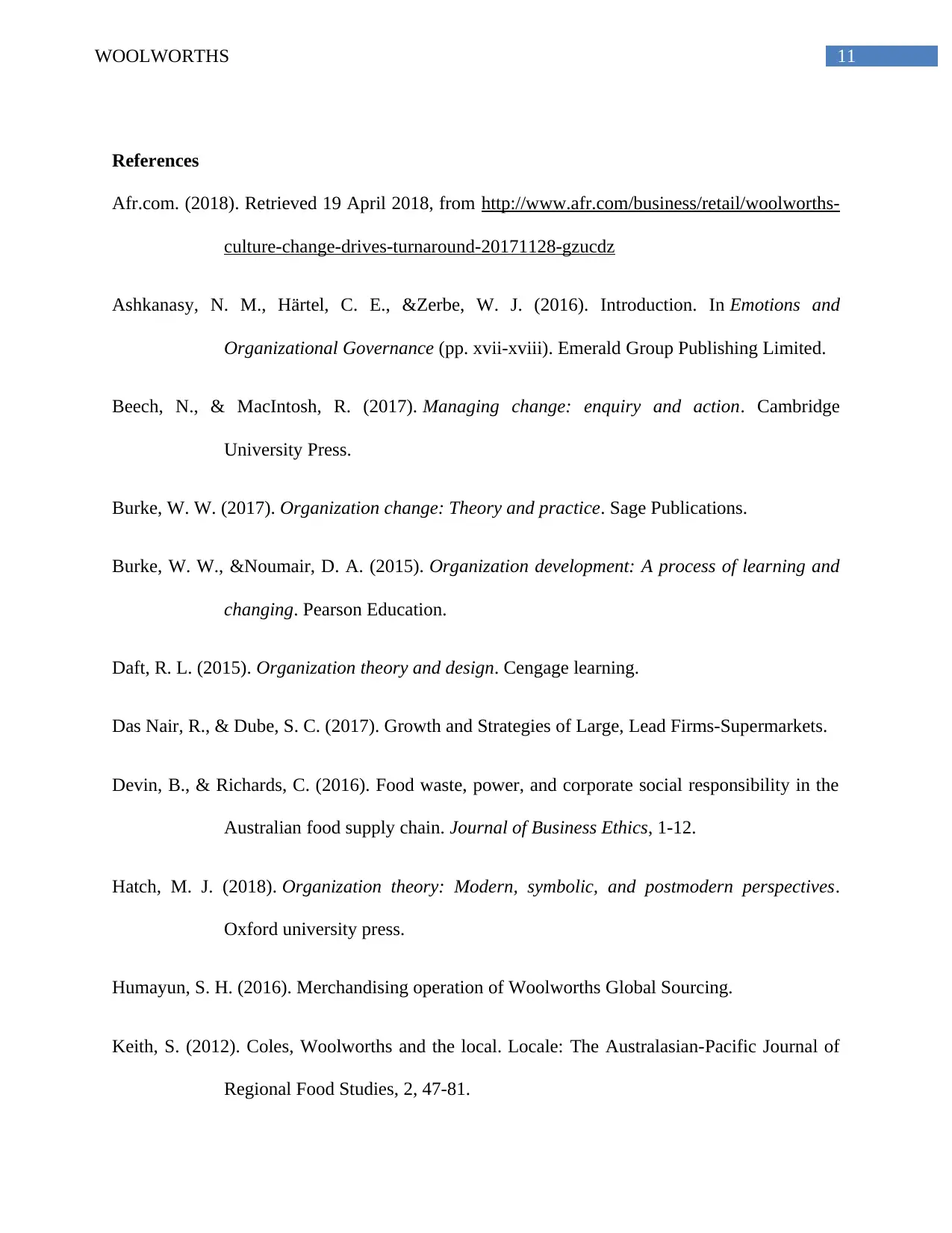
11WOOLWORTHS
References
Afr.com. (2018). Retrieved 19 April 2018, from http://www.afr.com/business/retail/woolworths-
culture-change-drives-turnaround-20171128-gzucdz
Ashkanasy, N. M., Härtel, C. E., &Zerbe, W. J. (2016). Introduction. In Emotions and
Organizational Governance (pp. xvii-xviii). Emerald Group Publishing Limited.
Beech, N., & MacIntosh, R. (2017). Managing change: enquiry and action. Cambridge
University Press.
Burke, W. W. (2017). Organization change: Theory and practice. Sage Publications.
Burke, W. W., &Noumair, D. A. (2015). Organization development: A process of learning and
changing. Pearson Education.
Daft, R. L. (2015). Organization theory and design. Cengage learning.
Das Nair, R., & Dube, S. C. (2017). Growth and Strategies of Large, Lead Firms-Supermarkets.
Devin, B., & Richards, C. (2016). Food waste, power, and corporate social responsibility in the
Australian food supply chain. Journal of Business Ethics, 1-12.
Hatch, M. J. (2018). Organization theory: Modern, symbolic, and postmodern perspectives.
Oxford university press.
Humayun, S. H. (2016). Merchandising operation of Woolworths Global Sourcing.
Keith, S. (2012). Coles, Woolworths and the local. Locale: The Australasian-Pacific Journal of
Regional Food Studies, 2, 47-81.
References
Afr.com. (2018). Retrieved 19 April 2018, from http://www.afr.com/business/retail/woolworths-
culture-change-drives-turnaround-20171128-gzucdz
Ashkanasy, N. M., Härtel, C. E., &Zerbe, W. J. (2016). Introduction. In Emotions and
Organizational Governance (pp. xvii-xviii). Emerald Group Publishing Limited.
Beech, N., & MacIntosh, R. (2017). Managing change: enquiry and action. Cambridge
University Press.
Burke, W. W. (2017). Organization change: Theory and practice. Sage Publications.
Burke, W. W., &Noumair, D. A. (2015). Organization development: A process of learning and
changing. Pearson Education.
Daft, R. L. (2015). Organization theory and design. Cengage learning.
Das Nair, R., & Dube, S. C. (2017). Growth and Strategies of Large, Lead Firms-Supermarkets.
Devin, B., & Richards, C. (2016). Food waste, power, and corporate social responsibility in the
Australian food supply chain. Journal of Business Ethics, 1-12.
Hatch, M. J. (2018). Organization theory: Modern, symbolic, and postmodern perspectives.
Oxford university press.
Humayun, S. H. (2016). Merchandising operation of Woolworths Global Sourcing.
Keith, S. (2012). Coles, Woolworths and the local. Locale: The Australasian-Pacific Journal of
Regional Food Studies, 2, 47-81.
⊘ This is a preview!⊘
Do you want full access?
Subscribe today to unlock all pages.

Trusted by 1+ million students worldwide
1 out of 14
Related Documents
Your All-in-One AI-Powered Toolkit for Academic Success.
+13062052269
info@desklib.com
Available 24*7 on WhatsApp / Email
![[object Object]](/_next/static/media/star-bottom.7253800d.svg)
Unlock your academic potential
Copyright © 2020–2025 A2Z Services. All Rights Reserved. Developed and managed by ZUCOL.





